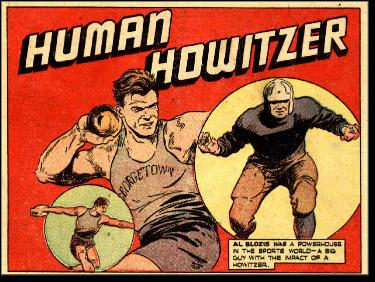
Sport: Football
Born: January 5, 1919
Died: January 21, 1945
Town: Jersey City, New Jersey
Albert Charles Blozis was born January 5, 1919 in Garfield, NJ. After his family moved to Hudson County, Al attended Dickinson High School in Jersey City. He was the star of the track team, using his 6’6″ 230-pound frame to propel the shot put and discus eye-popping distances.
The Dickinson basketball and football squads made use of Al’s ability, too. The football team produced a steady stream of talent during the 1930s, including future NFL running back Joe Sulaitis and Ed Franco, one of Fordham’s Seven Blocks of Granite. Like Franco, Al played the line.
Recruited primarily as a track athlete, Al accepted a scholarship to Georgetown (over Notre Dame) and proceeded to rewrite the record books in the shot put. In 1941, he set a world indoor record with a throw of 56’ 4.5”. He set more than three dozen records in this event as a Hoya. Al was the NCAA champion each year from 1940 to 1942 and was the AAU indoor and outdoor champ three times each. His best outdoor throw was 56′ 6.2″ and is top outdoor mark was 57′ 0.8″.
By this time, Al was a professional football player. Under the tutelage of Hoya coaches (and ex-New York Giants) Jack Hagerty and Mickey Murtagh, he overcame the awkwardness associated with his height and became a standout blocker. The coaches later claimed Al would have been an All-American had he not missed two practices a week because of his lab work as a chemistry major.
Tipped off to his potential by their former players, the Giants took Al in the fifth round of the 1942 draft. He was an All-Star as a rookie and earned All-Pro honors in his second season. Mel Hein, the All-Pro center for the Giants, claimed that Al could have been the greatest tackle who ever played. Hein played beside Al on the offensive line and behind him on defense, where Hein stationed himself as a linebacker. Al was also a great coverage man on kickoffs. He often made tackles before his teammates got within 20 feet of the ball carrier. As a physical specimen, Al was unmatched in the NFL. Arthur Daley of the New York Times described him stripped down to his skivvies as “an awe-inspiring site.”
Al didn’t feel right about playing pro ball while others were fighting. He visited more than one enlistment station only to be turned away because he exceeded the military’s height limit. Finally, in December of 1943, he persuaded the Army to take him.
Al began his military career as a physical instructor at Walter Reed Hospital in Washington, DC. Like many well-known pro athletes, he was kept out of harm’s way and participated in various morale-building functions as part of his service. As a result of his college degree, he started military life as a lieutenant. Later, Al was transferred to Ft. Benning in Georgia. There he set a record by throwing a hand grenade 94 yards—an army record that still stands. During 1944, Al was able to get furloughs and play in three NFL games for the Giants.
Al wasn’t happy as an instructor and lobbied to join the fighting in Europe. He was commissioned as a captain and sent to France. In January of 1945, his platoon was in the Vosges Mountains, on the French-German border. When two of his men failed to return from a scouting mission, Al went after them alone. He was never seen alive again. Al’s bullet-riddled body wasn’t found until April. In 1986, though long forgotten by most football fans, Al was enshrined in the College Football Hall of Fame.